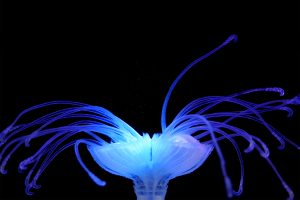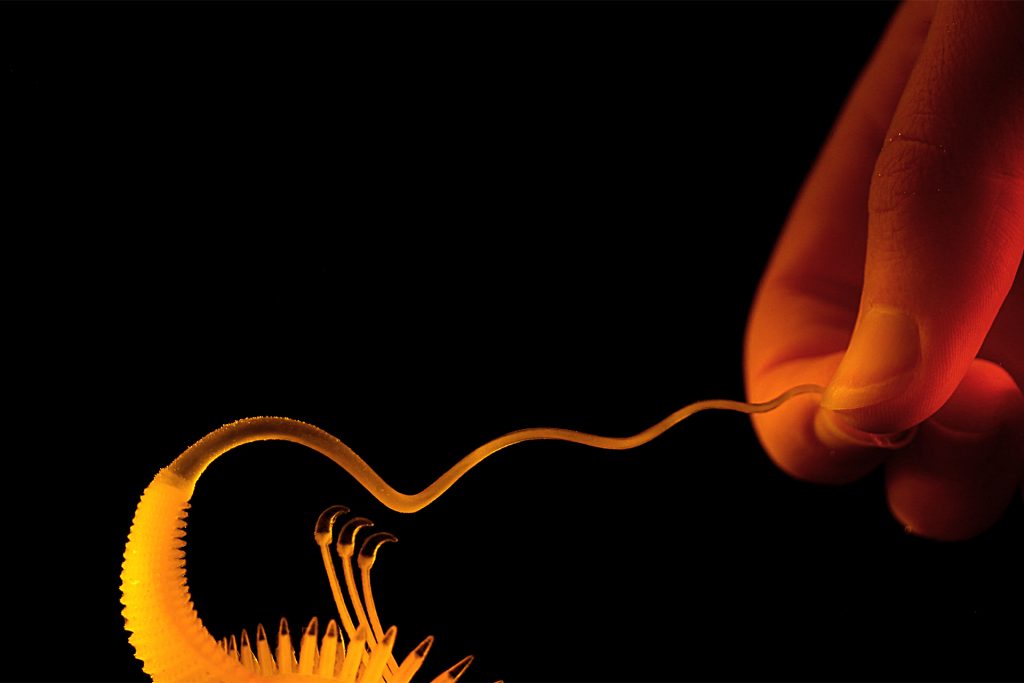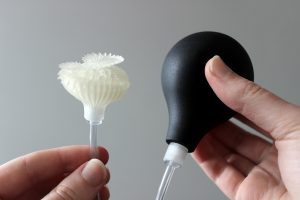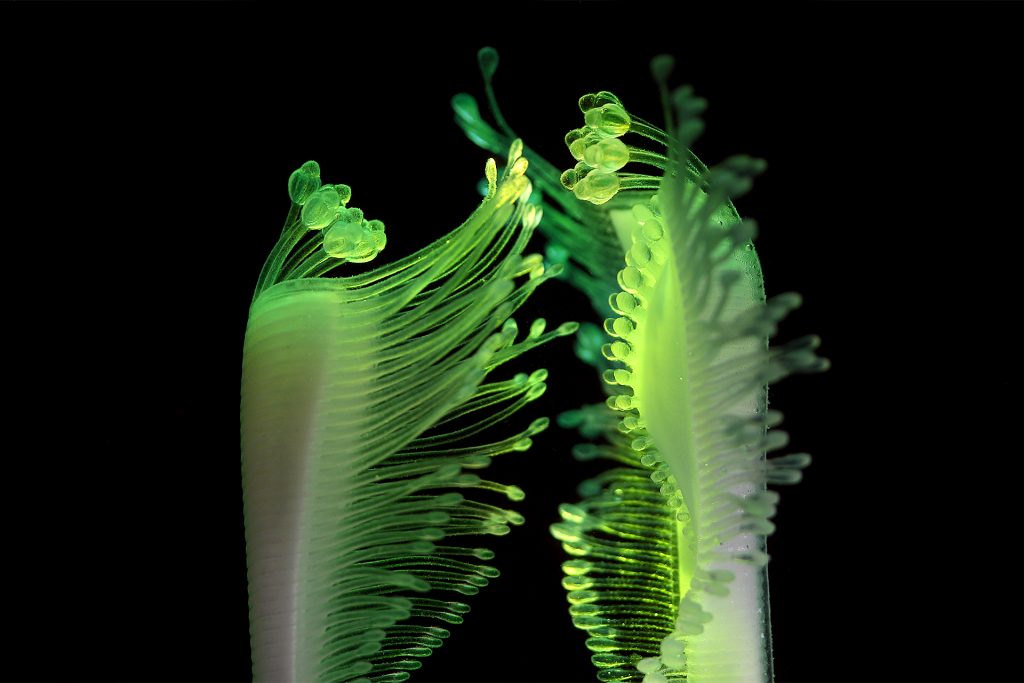A unique vision of underwater plants could pave the way for new film experiences. The film industry is going into new places with 3D printing, such as with the Black Panther’s Oscar-winning costume designs which included custom made 3D prints, and let’s not forget the groundbreaking technology used by New Zealand’s Weta Workshop when they ventured into J.R.R. Tolkien’s Lord of the Rings trilogy back in the early 2000s, making 3D printed objects for film props and costumes. In 2018 one student’s master thesis based on 4D multi-material printing has sparked the interest of Sir Richard Taylor, Weta’s co-founder and director. This thesis may mean that the film industry will take a serious interest in 4D printing as well.
Nicole Hone, an industrial designer and graduate student of Victoria University in Wellington, in New Zealand, created Hydrophytes, a project that shows the adaptive qualities of 4D printing -the creation of 3D printed objects that can move or change their shape or appearance through responding to external stimuli, such as temperature change or water absorption.
The Hydrophytes project evoques the beauty of the aquatic plants that go by the same name, and bring Hone’s vision to life. They are beautiful to watch as they slither, twist and expand smoothly imitating the living water organisms. They are a moving, almost breathing work of art, and proof of how far the 3D printing technology can go in recreating organic forms. 3DPrint.com interviewed Hone in order to find out more about her project.
“Ever since I was a child I have loved art, drawing, painting, sculpting with clay and photography, and having access to multi-material 3D printing throughout my time at university was the initiator of my eventual interest in 4D printing. The way that PolyJet technology structures objects with variable material properties, and even the feel and behaviour of digital materials, is becoming more like natural biology are qualities that drew me to this type of 3D printing. I have always been fascinated with nature, especially botany and marine life, because not only does the natural world provide a wealth of beautiful and strange visuals but the way that things grow, adapt and move is also amazing,” Hone explained to 3D Print.com during an interview.
In the context of her research project, Hone used Stratasys PolyJet technology in combination with pneumatic inflation techniques to create moving 4D printed objects. According to Hone, Polyjet lets her print blends of rigid and flexible resins within a single object. Acrylic-based and rubber-like photopolymers, known as Vero and Tango respectively, can be blended and printed simultaneously to create gradient parts. This process is also known as using digital materials. Hone found that if these materials are used correctly parts can have shape memory properties that let them revert to their original shape or position when manipulated. She then used her insight to make 3D printed ‘creatures’ that seemingly move as if they have a life of their own.
“I think there is something fascinating about seeing an object move independently and come to life in front of your very eyes. Experiencing the 4D prints in person, being able to interact with them and watching how others respond to the prints are all enjoyable parts of the process,” suggested the designer whose future-oriented mindset hope to help man and nature live more harmoniously together through the utilisation of technology.
“The Hydrophytes were done on the Stratasys Objet Connex 350, making it ideal for printing small objects with fragile parts and complex organic forms. Internal structures and movement mechanisms can also be effectively designed which allowed the creation of pneumatically-activated prints. The Hydrophyte creatures demonstrated a range of complex organic movements and personalities, previously unexplored with PolyJet technology. Part of this movement is designed by 3D modelling their internal chambers, the shape and thickness of each part and how they intersect. The 4D prints also exploit the flexibility and performative qualities of digital materials,” she described.
This project brings the digital and physical worlds closer together. Hone’s Hydrophytes can interact with their surroundings in the physical space, responding to external forces such as gravity and water motion as well as people.
“This response happens in a way that is natural and conforms to the ‘rules’ of the real world as opposed to computer animation. With CGO (computer generated objects), designers can take advantage of both the digital and the physical world, where objects can interact naturally with the surrounding environment. This balance between controlled design and uncontrolled natural interaction leads to the creation of compelling organic performances,” stated the designer, who recently completed her master’s degree in Design Innovation.
It’s Tangible Animation! Bringing objects to life in the same world as the audience, with multi-material 4D printing. This is advantageous for both the film and exhibition industries where immersive experiences are a growing trend. Film props created with multi-material 4D printing could help prompt genuine reactions from actors and create convincing object-environment interactions.
Hone also defines this Tangible Animation as cinematic ‘magic’ that can be transformed into authentic physical encounters for theme parks, multi-sensory interactive experiences in museums or aquariums, as well as robotics, architecture and medicine, potentially helping create aquatic soft robots, adaptive surfaces or functioning organs.
“I would love to continue bringing objects to life, whether it’s animals, fictional characters or even dinosaurs. The development of new materials for PolyJet printing and voxel technology offer exciting opportunities to create more complex, realistic and larger 4D printed objects; the incorporation of sensors, smart materials or even living materials would offer an enhanced ability to design movement and create objects that really are alive!”
Hone hopes to start working at Weta soon, after successfully completing an internship in 2017 where she met Taylor. In the future, she looks forward to designing content for exhibition spaces or films, “creating experiences that can amaze and intrigue people”. Surely her love for nature and admiration at the relationship between humans, the environment and technology will continue to amaze us in the years to come.
Subscribe to Our Email Newsletter
Stay up-to-date on all the latest news from the 3D printing industry and receive information and offers from third party vendors.
You May Also Like
3D Printing News Briefs, April 13, 2024: Robotics, Orthotics, & Hypersonics
In 3D Printing News Briefs today, we’re focusing first on robotics, as Carnegie Mellon University’s new Robotics Innovation Center will house several community outreach programs, and Ugogo3D is now working...
Rail Giant Alstom Saves $15M with 3D Printing Automation Software 3D Spark
3D Spark has entered into a three-year deal with the rail giant Alstom. Alstom, a transport behemoth with annual revenues of $16 billion, specializes in the manufacture of trains, trams,...
Meltio Expands Global Reach with New Partnerships in the Americas and Europe
Spanish 3D printing manufacturer Meltio has expanded its sales network across the globe. With the addition of three new partners in the United States, Brazil, Argentina, and Italy, Meltio aims...
3D Printing Webinar and Event Roundup: April 7, 2024
Webinars and events in the 3D printing industry are picking back up this week! Sea-Air-Space is coming to Maryland, and SAE International is sponsoring a 3D Systems webinar about 3D...




































